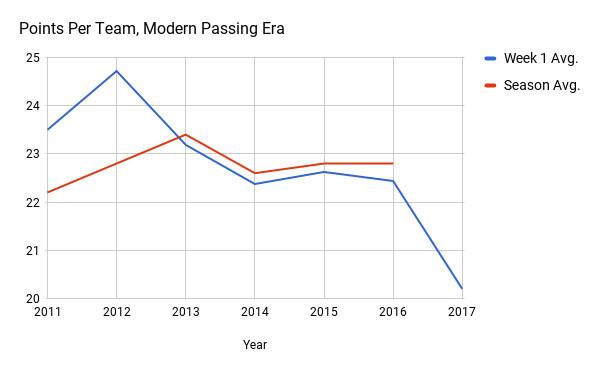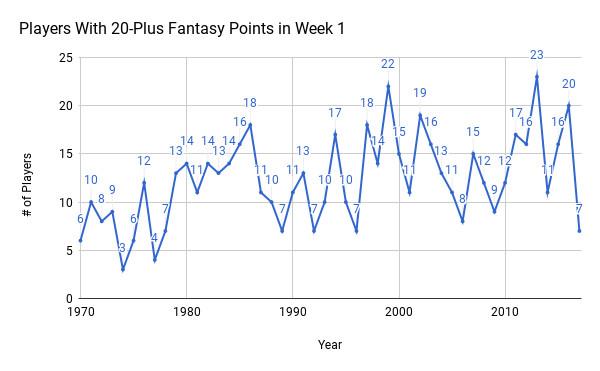
In between the Chiefs’ shellacking of the Patriots to start Week 1 of the NFL season and the feisty Broncos-Chargers duel to end it, what was the most exciting moment of professional football last weekend? Was it the entrance of Texans quarterback savior Deshaun Watson? Either of Sunday’s NFC East battles? The Packers-Seahawks clash, billed as a potential NFC championship preview?
The answer is none of the above. It all underwhelmed, the whole lot of Week 1 football in between Thursday and Monday nights. Watson underwhelmed in his NFL debut, a blowout loss to the Jaguars. The Washington-Philadelphia and Dallas–New York games underwhelmed due to erratic quarterback and offensive line play. And the Packers-Seahawks’ Sunday afternoon matchup underwhelmed thanks to a cascade of ill-timed penalties, slogging offensive series, and a general lack of highlights.
Throughout the league more broadly, teams couldn’t move the ball, standout performers were scant, and scoreboards stayed stagnant. It was just one week, and chances are good that it will prove a fluke rather than a harbinger of boring football to come. But there’s another week to go until teams can start making amends; chances are also good that Thursday night’s Bengals-Texans survival match won’t be the game to turn the 2017 season’s fortunes around. For now, then, let’s dive deeper into the muck and examine 10 stats that illustrate the giant shrug that embodied most of Week 1.
1. Through the first week, NFL teams are averaging 20.2 points per game. Since 2011, when the modern passing revolution hit an accelerated gear (quarterbacks have recorded 14 of the 16 4,900-yard passing seasons in league history in the past six seasons), that average is more than two points worse than any other year’s Week 1.

As this graph also shows, it’s not as if Week 1 is a particularly tricky time to score, or that offenses regularly struggle to jell early; rather, first-week scoring averages over the past few seasons have tracked closely with 17-week scoring averages. Over the 2011-2016 period, teams scored 23.1 points per game in Week 1 and 22.8 points per game over the full season. NFL fans should hope this year proves an outlier in that respect, or many more low-scoring games will come over the next few months.
2. Last year, half the Week 1 contests saw both teams score 20-plus points. The year before, seven did. This year, that number was three—the lowest in more than a decade, and a total that befits the 1970s, when there were fewer teams and even fewer dynamic offenses, better than the 2010s.
3. To the detriment of viewers, that paucity of high scores was acutely concentrated when the games on television were scarcer. During Sunday’s afternoon and evening slate, for instance, there was no game with even moderately lofty point totals to turn to. That bloc featured four games, of which precisely zero involved both teams reaching double-digit point totals.
4. Yet even the suppressed point totals couldn’t produce many fun finishes. Monday’s Broncos-Chargers tilt came down to the final seconds, but on Sunday, only three contests were decided by eight points or fewer, and only one was really that close in spirit. Atlanta repelled a last-minute Chicago drive to preserve a 23-17 victory, but neither Cleveland (against Pittsburgh) nor Seattle (against Green Bay) ran another offensive play after cutting their respective deficits to a single score late in the fourth quarter.
5. Last year, for comparison, 11 Week 1 games had margins of eight points or fewer. The year before that, there were nine; before that, eight; and before that, 12 in 2013, the most-ever such Week 1 games. The most recent year with as few close Week 1 games as this year had was 1976.
6. In general, teams experienced difficulties moving the ball efficiently, averaging only 5.07 yards per play—or approximately what the Vikings and Browns averaged through all of last season. The Week 1 yards-per-play average exceeded 5.33 in each of the six other years since 2011. That difference might not sound like a lot, but it’s worth an extra few first downs over the course of a typical game.
7. Our own Danny Kelly already covered the leaguewide rushing issues: mainly, that touchdowns, yards, and yards per carry lagged compared to recent Week 1s. Unsurprisingly given the above point totals, quarterback play was also spotty throughout the league. Scoring through the air was down, for one: The league combined for 38 touchdown passes, whereas in every other Week 1 since 2011, QBs have combined for at least 48.
8. We knew entering Sunday’s games that a frightening amount of bad quarterback play was on the docket, and for the most part, those fears were founded. Scott Tolzien, Tom Savage, and Josh McCown, for instance, combined to throw four interceptions without a score, leading those first two arms to the bench and yielding a 50.7 cumulative passer rating for the trio. For comparison, Ryan Leaf’s career mark was 50.0.
9. It wasn’t just the Tolziens and Savages, though, who sputtered in the opening weekend. Andy Dalton delivered the first zero-TD, four-INT game of his uneven career; Eli Manning captained the most tepid national-TV offense imaginable; Russell Wilson, Cam Newton, and Joe Flacco all completed barely more than half their throws, each finishing well short of even 200 yards passing. And in the most surprising Week 1 stat of all, of the 33 players who threw a pass, Tom Brady had the worst completion percentage.
10. Missing most from Week 1 were the big performances we’ve come to expect in this age of high-octane offense: the stat-sheet stuffers, the electrifying multi-touchdown breakouts, the performances that swing entire fantasy destinies. But after the Chiefs and Patriots started strong in this regard, the rest of the league faltered. On Sunday, no running back rushed for multiple touchdowns, and only Matthew Stafford tossed more than two TDs. Accordingly, Stafford was the only Sunday player to reach 20 fantasy points in a standard, non-PPR league; for all of the Week 1 slate, only seven players surpassed that benchmark.
Even though it focuses on fantasy rather than the actual gameplay, that stat might be the most damning. It’s tied for the lowest total since—again—the mid-1970s, and it’s especially low compared to its equivalents in recent, offense-dominant years.

When defenses are just as likely to record bulky fantasy outputs as skill-position players, the internal calculus of the sport has gone wonky. A Week 2 reset of scoring norms would represent a positive development for fantasy owners—and, after an underwhelming first week, a welcome sight for all NFL viewers craving an exciting game.

